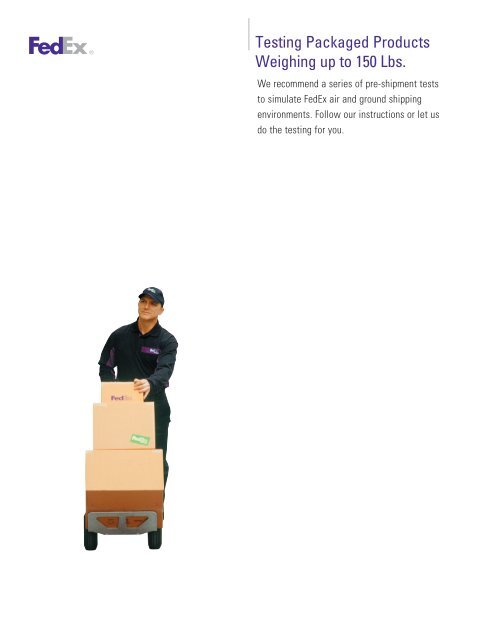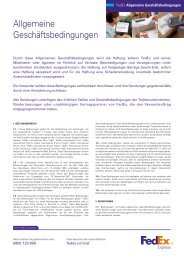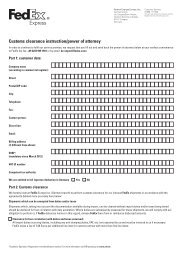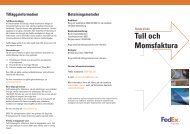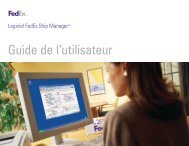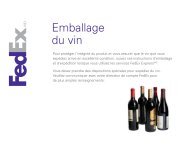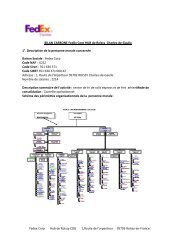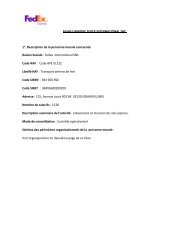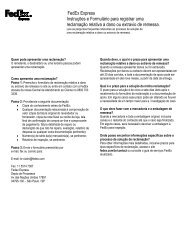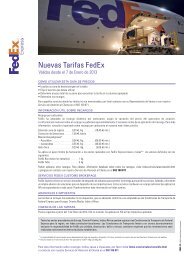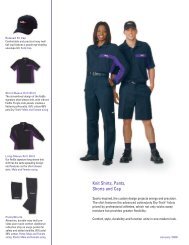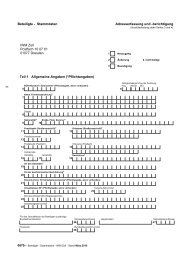Testing Packaged Products Weighing up to 150 Lbs. - FedEx
Testing Packaged Products Weighing up to 150 Lbs. - FedEx
Testing Packaged Products Weighing up to 150 Lbs. - FedEx
Create successful ePaper yourself
Turn your PDF publications into a flip-book with our unique Google optimized e-Paper software.
<strong>Testing</strong> <strong>Packaged</strong> <strong>Products</strong><br />
<strong>Weighing</strong> <strong>up</strong> <strong>to</strong> <strong>150</strong> <strong>Lbs</strong>.<br />
We recommend a series of pre-shipment tests<br />
<strong>to</strong> simulate <strong>FedEx</strong> air and ground shipping<br />
environments. Follow our instructions or let us<br />
do the testing for you.
Overview of General <strong>Testing</strong> Procedures<br />
<strong>FedEx</strong> package testing procedures are based on industry<br />
data, as well as international testing procedures and<br />
standards, <strong>to</strong> provide reliable packaging tests for our<br />
cus<strong>to</strong>mers with an active <strong>FedEx</strong> account number. Here<br />
we outline the general simulation procedures for testing<br />
packaged products weighing <strong>up</strong> <strong>to</strong> <strong>150</strong> lbs. We use drop,<br />
impact, compression and vibration tests <strong>to</strong> evaluate the<br />
integrity and protective performance of the packaging.<br />
We also consider package closure performance an<br />
important acceptance criterion. We routinely open<br />
packaging and inspect the contents after completion<br />
of all test procedures, unless obvious damage is noted<br />
during or after an individual test. If at any point during<br />
the testing sequences damage is noted, further testing<br />
may not be completed.<br />
Tests for <strong>Packaged</strong> <strong>Products</strong><br />
<strong>Weighing</strong> <strong>up</strong> <strong>to</strong> <strong>150</strong> <strong>Lbs</strong>.<br />
(Same as ISTA-6-<strong>FedEx</strong>-A)<br />
We follow a strict sequence of testing procedures,<br />
performing tests on each sample in the sequence<br />
indicated in the following table.<br />
Tests for <strong>Packaged</strong> <strong>Products</strong> <strong>Weighing</strong> Up <strong>to</strong> <strong>150</strong> lbs.<br />
Product/Service Electronic, Powered, Medical Items<br />
U.S. Shipments International Shipments<br />
All Other Items<br />
Regular Flat Elongated Regular Flat Elongated<br />
Free-Fall Drop Test* X X X X X X X X X<br />
Concentrated Impact Test X X X<br />
Bridge Impact Test X X X<br />
Compression Test X X X X X X X X X<br />
Rotary Vibration Test X X X<br />
Random Vibration Test – U.S.** X X X<br />
All Items<br />
Random Vibration Test – International** X X X<br />
Second Free-Fall Drop Test* X X X<br />
* Computer-aided data acquisition and analysis are available <strong>up</strong>on request.<br />
** The random vibration system can test samples <strong>up</strong> <strong>to</strong> 200 lbs., and the rotary vibration table can test samples <strong>up</strong> <strong>to</strong> 1,250 lbs.<br />
Contact <strong>FedEx</strong> Packaging Services before sending test samples weighing more than 200 lbs.<br />
The <strong>FedEx</strong> Packaging Services department reserves the right <strong>to</strong> alter the test sequence or equipment used <strong>to</strong> accommodate special package characteristics, commodities or testing equipment<br />
limitations <strong>to</strong> provide the most representative test possible. When package or content conditions are uncertain, or conditional on cus<strong>to</strong>mer input, a “Post-Test Inspection Notice” will be sent<br />
with the report after the test is completed.<br />
For packaged products over <strong>150</strong> lbs., please refer <strong>to</strong> the <strong>FedEx</strong> <strong>Testing</strong> <strong>Packaged</strong> <strong>Products</strong> <strong>Weighing</strong> More Than <strong>150</strong> <strong>Lbs</strong>. brochure.<br />
Regular Flat Elongated<br />
Page 2
Packaging Definitions<br />
For testing purposes, we classify packaging in<strong>to</strong> three<br />
categories. Use these simple definitions <strong>to</strong> determine if<br />
your packaging configuration is flat, elongated or regular.<br />
Flat Package<br />
We classify a package as flat if the shortest dimension<br />
is less than or equal <strong>to</strong> 8", the next shortest dimension<br />
is at least four times the length of the shortest dimension,<br />
and the volume of the <strong>to</strong>tal package is at least 800<br />
cubic inches.<br />
Elongated Package<br />
We classify a package as elongated if the longest<br />
dimension is at least 36" and the other two dimensions<br />
measure 20 percent or less than the longest dimension.<br />
Regular Package<br />
We classify any package that is not defined as flat or<br />
elongated as a regular package.<br />
Impact Tests<br />
Free-Fall Drop Tester<br />
Package Weight Drop Height<br />
Free-Fall Drop Test Procedures<br />
We employ a free-fall drop tester* <strong>to</strong> drop packages on<strong>to</strong><br />
a flat, firm, nonyielding steel base. We vary the drop<br />
height based on the package weight shown in the chart.<br />
For international products, we conduct a second sequence<br />
of free-fall drop tests following the vibration test.<br />
We conduct 10 drop tests, one for each of the orientations,<br />
shown in the box examples below.<br />
1. Most fragile corner.<br />
Drops<br />
per Sequence<br />
Equal <strong>to</strong> or less 30" 10<br />
than 75 lbs.<br />
Greater than 75 lbs. 24" 10<br />
but equal <strong>to</strong> or less<br />
than 100 lbs.<br />
Greater than 100 lbs. 18" 10<br />
but equal <strong>to</strong> or less<br />
than <strong>150</strong> lbs.<br />
2. Shortest edge radiating from the drop corner.<br />
* Computer-aided data acquisition and analysis are available <strong>up</strong>on request.<br />
Page 3
3. Medium edge radiating from the drop corner.<br />
4. Longest edge radiating from the drop corner.<br />
5. Flat on one of the smallest faces.<br />
6. Flat on the opposite small face.<br />
7. Flat on one of the medium faces.<br />
8. Flat on the opposite medium face.<br />
9. Flat on one of the largest faces.<br />
10. Flat on the opposite large face.<br />
NOTE: When it comes <strong>to</strong> irregularly shaped items, we follow special drop<br />
orientation procedures.<br />
Page 4
Concentrated Impact Test for Flat Packages Bridge Impact Test for Elongated Packages<br />
Concentrated Impact Test Procedures<br />
We use a free-fall drop tester <strong>to</strong> drop a dense wooden<br />
box measuring 12" x 12" x 12", with one bot<strong>to</strong>m edge<br />
covered by an angle iron, on<strong>to</strong> the test package. The<br />
box should have a <strong>to</strong>tal weight of 21 lbs., filled with a<br />
sandbag <strong>to</strong> achieve the weight and void fill <strong>to</strong> hold the<br />
bag in place. To perform this test, we use the<br />
following procedures.<br />
1. Place the package with its largest surface area on a<br />
nonyielding steel or concrete base.<br />
2. Measure and mark the center of the test package in<br />
both directions. Raise the drop tester platen <strong>to</strong> 30".<br />
3. Position the wooden box on the drop platen so that<br />
the angle-iron edge is pointed <strong>to</strong>ward the package<br />
and is parallel <strong>to</strong> the shortest dimension of the largest<br />
package face. Mark the midpoint of the wooden box<br />
impact edge and ensure that it is lined <strong>up</strong> with the<br />
marked test-package midpoint.<br />
4. Allow the box <strong>to</strong> fall freely and impact the package at<br />
the marked midpoints evenly, without attempting <strong>to</strong><br />
catch any rebound of the wooden box.<br />
Bridge Impact Test Procedures<br />
We use a free-fall drop tester <strong>to</strong> drop a dense wooden<br />
box measuring 12" x 12" x 12", with one bot<strong>to</strong>m edge<br />
covered by an angle iron, on<strong>to</strong> the test package. The<br />
box should have a <strong>to</strong>tal weight of 21 lbs., filled with a<br />
sandbag <strong>to</strong> achieve the weight and void fill <strong>to</strong> hold the<br />
bag in place. To perform this test, we use the<br />
following procedures.<br />
1. Place the test package on two 4"-high blocks at opposite<br />
ends of the longest package dimension and parallel <strong>to</strong><br />
each other at the shortest package edge.<br />
2. Measure and mark the center of the test package in<br />
both directions. Raise the drop tester platen <strong>to</strong> 30".<br />
3. Position the wooden box on the drop platen so that<br />
the angle-iron edge is pointed <strong>to</strong>ward the package and<br />
is parallel <strong>to</strong> the shortest dimension of the largest<br />
package face. Mark the midpoint of the wooden box<br />
impact edge and ensure that it is lined <strong>up</strong> with the<br />
marked test-package midpoint.<br />
4. Allow the box <strong>to</strong> fall freely and impact the package at<br />
the marked midpoints evenly, without attempting <strong>to</strong><br />
catch any rebound of the wooden box.<br />
Page 5
Compression Test<br />
Compression Tester<br />
Shipping Unit Construction<br />
F-Fac<strong>to</strong>rs<br />
Assurance Level<br />
II III<br />
Corrugated, fiberboard or plastic container 10.0 7.0 5.0<br />
that may or may not have stress-bearing<br />
interior packaging using these materials,<br />
and where the product does not s<strong>up</strong>port<br />
any of the load.<br />
Corrugated, fiberboard or plastic container 6.0 4.5 3.0<br />
that has stress-bearing interior packaging<br />
with rigid inserts such as wood.<br />
Containers constructed of materials other 4.0 3.0 2.0<br />
than corrugate, fiberboard or plastic that are<br />
not temperature- or humidity-sensitive, or<br />
when the product s<strong>up</strong>ports the load directly.<br />
The F-Fac<strong>to</strong>r is normally set <strong>to</strong> Assurance Level III and may vary as shown.<br />
I<br />
Compression Test Procedures<br />
We perform the compression test on a dynamic compression<br />
tester equipped with a computerized control system. To<br />
perform this test, we use the following procedures.<br />
1. Calculate the compression load using this formula:<br />
Compression Load (pounds) =<br />
0.007 x (108 – H) x L x W x F<br />
• 0.007 = Average density of freight in pounds per<br />
cubic inch (12 lbs. per cubic foot).<br />
• 108 = Maximum height (inches) of package stack<br />
in transit.<br />
• H = Height of shipping unit (inches).<br />
• L = Length of shipping unit (inches).<br />
• W = Width of shipping unit (inches).<br />
• F = A fac<strong>to</strong>r <strong>to</strong> account for humidity, time and<br />
stacking pattern.<br />
2. Set <strong>up</strong> the compression tester for the s<strong>to</strong>p force,<br />
equivalent <strong>to</strong> the compression load calculated in<br />
step 1, the yield detection percentage (15 percent)<br />
and<br />
s<strong>to</strong>p deflection (1").<br />
3. Center the packaged product on the lower platen of the<br />
compression tester.<br />
4. Bring platens <strong>to</strong>gether at 0.5" per minute.<br />
5. Conclude the test when one of these conditions is first<br />
detected by the compression tester:<br />
• The s<strong>to</strong>p force.<br />
• The yield detection percentage.<br />
• The s<strong>to</strong>p deflection.<br />
Page 6
Vibration Tests<br />
Random Vibration Tester<br />
Truck and Aircraft Random Vibration Profiles<br />
Truck Random Vibration Profile<br />
Aircraft Random Vibration Profile<br />
Random Vibration Test Procedures<br />
We perform the random vibration test on a vertical<br />
electrohydraulic vibration machine equipped with<br />
computerized controls. To perform this test, we use<br />
the following procedures.<br />
1. Program the vibration system <strong>to</strong> reproduce three<br />
consecutive sequences of random vibration profiles<br />
representing the <strong>FedEx</strong> distribution environment as<br />
indicated in the spectra profiles.<br />
• Truck vibration at 0.52 Grms (profile one).<br />
• Air vibration at 1.06 Grms (profile two).<br />
• Repeat truck vibration at 0.52 Grms (profile one).<br />
2. Set the duration of each sequence at 15 minutes for U.S.<br />
shipments, 30 minutes for international shipments.<br />
3. Place the test package on the vibration table. Fixtures<br />
may be used during testing <strong>to</strong> prevent the package<br />
from moving off the table, <strong>to</strong> prevent unsafe conditions<br />
or <strong>to</strong> maintain test orientation without restricting the<br />
vertical movement.<br />
4. Load the appropriate au<strong>to</strong>matic sequences of random<br />
vibration profiles and perform tests.<br />
Page 7
Rotary Vibration Tester<br />
Rotary Vibration Test Procedures<br />
We perform the rotary vibration test on a mechanical rotary<br />
vibration machine. The machine will vibrate at 1.0" <strong>to</strong>tal<br />
displacement. Packages will be subjected <strong>to</strong> a <strong>to</strong>tal of<br />
14,200 vibra<strong>to</strong>ry impacts. To perform this test, we use the<br />
following procedures.<br />
1. Place the package on the vibration table. Fixtures<br />
may be used during testing <strong>to</strong> prevent the test sample<br />
from moving off the table, <strong>to</strong> prevent unsafe conditions<br />
or <strong>to</strong> maintain test orientation without restricting the<br />
vertical movement.<br />
2. Start the vibration table at its lowest speed of<br />
frequency. Maintain the 1.0" fixed displacement and<br />
slowly increase the speed (frequency) of the vibration<br />
table until the test sample begins <strong>to</strong> momentarily leave<br />
the surface of the vibration table. Record the speed in<br />
cycles per minute (CPM) or frequency in cycles per<br />
second (Hz) and s<strong>to</strong>p the vibration table.<br />
3. Determine the vibration test duration in minutes based<br />
on the speed (CPM) or frequency (Hz) identified in step 2,<br />
using the following formula:<br />
Test Duration (minutes) =<br />
14.200 Vibra<strong>to</strong>ry Impacts ÷ Speed (CPM)<br />
or [Frequency (Hz) x 60]<br />
4. Start the vibration table <strong>to</strong> vibrate at the speed (CPM) or<br />
frequency (Hz) identified in step 2. S<strong>to</strong>p the vibration test<br />
halfway through the vibration test duration determined<br />
in step three.<br />
5. Rotate the test sample 90 degrees horizontally. Resume<br />
the vibration speed (CPM) or frequency (Hz) for the<br />
remaining vibration test duration. Flat and elongated<br />
packages will be vibrated on their smallest and largest<br />
surfaces respectively.<br />
<strong>Testing</strong> Request Guidelines<br />
Follow these steps for submitting your packaging for<br />
testing. An active <strong>FedEx</strong> account number is required.<br />
You and your <strong>FedEx</strong> account executive should expect<br />
testing results via email in approximately five <strong>to</strong> seven<br />
business days from when <strong>FedEx</strong> Packaging Services<br />
receives your packaging.<br />
1. Obtain a <strong>FedEx</strong> Packaging Test Application at<br />
fedex.com/packaging or by contacting <strong>FedEx</strong><br />
Packaging Services at packagingservices@fedex.com<br />
or 1.800.633.7019.<br />
2. Complete and sign your application, referencing the<br />
name of your <strong>FedEx</strong> account executive on the form.<br />
See the <strong>FedEx</strong> Packaging Test Application for terms<br />
governing testing or design.<br />
3. Prepare a sample test package including all the<br />
packaging components and contents in the exact<br />
configuration you intend <strong>to</strong> send <strong>to</strong> your cus<strong>to</strong>mer.<br />
4. Place your completed application, your sample test<br />
package labeled “Test This Package” and any necessary<br />
cushioning material in a sturdy outer container marked<br />
“Overpacked/Test Pkg. Inside.”<br />
5. Send your shipment <strong>to</strong> the address indicated on the<br />
<strong>FedEx</strong> Packaging Test Application.<br />
Page 8
Shipping Instructions<br />
You may send <strong>up</strong> <strong>to</strong> three package samples for testing and<br />
analysis per submission. We require that you overpack<br />
(or overbox) the product <strong>to</strong> be tested and its packaging.<br />
Cushioning material<br />
Test package with<br />
completed application<br />
enclosed and “Test<br />
This Package” marking<br />
Sturdy outer container<br />
“Overpacked/Test Pkg. Inside”<br />
marking on the outside of<br />
the container<br />
Complimentary <strong>Testing</strong> and Return Shipping<br />
<strong>FedEx</strong> Packaging Services will test your packaging at no<br />
charge. You simply cover the costs of shipping your test<br />
package <strong>to</strong> <strong>FedEx</strong> Packaging Services.<br />
Then, if you request, we will return your test package<br />
free of charge via <strong>FedEx</strong> Express Saver ® or <strong>FedEx</strong> Ground ®<br />
service. Of course, you may request return of your<br />
packaging via other <strong>FedEx</strong> services at your own expense.<br />
No Hazardous Materials <strong>Testing</strong> for<br />
<strong>FedEx</strong> Ground Shipments<br />
<strong>FedEx</strong> Packaging Services does not test packaging<br />
containing hazardous materials. If you would like <strong>to</strong><br />
have this type of packaging tested, you may substitute<br />
contents with non-hazardous materials, or we can help<br />
you find labora<strong>to</strong>ries <strong>to</strong> perform these specialized<br />
testing services.<br />
No Dangerous Goods <strong>Testing</strong> for<br />
<strong>FedEx</strong> Express ® Shipments<br />
<strong>FedEx</strong> Packaging Services does not test packaging<br />
containing dangerous goods or simulated dangerous<br />
goods. We can help you find labora<strong>to</strong>ries <strong>to</strong> perform<br />
these specialized testing services.<br />
Contacts and Resources<br />
• How <strong>to</strong> Pack guidelines at fedex.com/packaging.<br />
• <strong>FedEx</strong> Packaging Services lab,<br />
packagingservices@fedex.com or 1.800.633.7019.<br />
• <strong>FedEx</strong> field packaging engineers,<br />
pkgfield@corp.ds.fedex.com. Or contact your<br />
<strong>FedEx</strong> account executive for a referral.<br />
NOTICE: This packaging brochure is provided <strong>to</strong> <strong>FedEx</strong> cus<strong>to</strong>mers <strong>to</strong> help reduce loss or damage due <strong>to</strong> improper packaging. It is NOT intended <strong>to</strong> be a comprehensive guide for packaging items<br />
we accept for transit. We make no warranties, expressed or implied, regarding this information. Proper packaging is the sole responsibility of the shipper. For more information and additional<br />
guidelines, go <strong>to</strong> the packaging tips page on fedex.com/packaging, email packagingservices@fedex.com or contact <strong>FedEx</strong> Packaging Services at 1.800.633.7019. Refer <strong>to</strong> the current <strong>FedEx</strong> Service<br />
Guide for terms, conditions and limitations applicable <strong>to</strong> <strong>FedEx</strong> ® delivery services.<br />
© 2011 <strong>FedEx</strong> 0004523PM-Rev. 3/11<br />
Page 9


